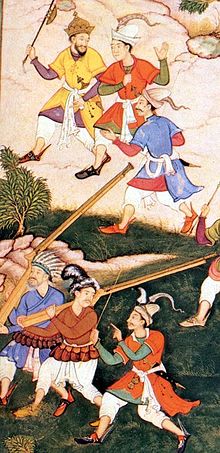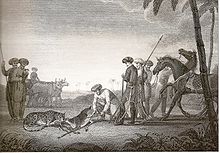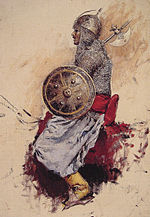- Mughal weapons
-
Mughal Weapons, The Military of the Mughal Empire used a variety of weapons in their conquests throughout the centuries. various types of: swords, bow (weapon) & arrows, horses, camels, elephants, various types of cannons (some of them the worlds largest), muskets and Flintlock Blunderbuss. Mughal weapons were greatly evolved during the ruling periods of Babur, Akbar, Aurangzeb and lastly Tipu Sultan, Mughal weapons have become very popular due to the recent RTS game Age of Empires 3: The Asian Dynasties expansion.
The art of Mughalwarfare brought about a complete change in the way wars were fought in the Indian subcontinent. The Muslim armies that invaded India in the 11th and 12th centuries were small yet the art of their warfare made invincible. They brought with them techniques and instruments of warfare that were hitherto unheard of in the sub-continent. The soldiers were completely protected from any possibility of physical attack by means of a complete shield of armour from head to foot, their daggers and swords were made of superior alloys and they brought with them the use of gunfire in warfare. That is why despite the courage and valour of the Indian armies a small group of warriors was able to overtake them and lay the foundation for one of the grandest Empires in Indian history, the Mughal Empire.
Contents
Weapons used in Mughal Warfare
The Mughals used various sophisticated weapons for warfare which was the prime reason for their triumph in the sub-continent. A major development in war was made by the introduction of gunpowder in Indian battle, a feat never accomplished before. Among the commonly used weapons are the sword and dagger, guns and cannon, archery and the extensive use of cavalry and infantry during war.
Talwar
Talwar with a wootz blade and silver koftigari decoration to hilt and blade forte. The Talwar was the most widely used weapon during Mughal times.
A major change was brought about in the shape and quality of swords since after the advent of the Mughal rule. They brought with them the curved sword, as opposed to the heavy straight swords with rounded ends as was in use at the time. These were sleek, sharp. Curved and made of a superior alloy of iron. The most superior quality blades were imported from Iran and made of crucible steel which gave it a crystalline appearance was capable of cutting deep into the armour and bodies of their adversaries. The ruler always carried with him a sword enclosed in a red sheath. The `Indo-Muslim` hilt, with its typical dish-shaped pommel, seems to have been introduced by the Mughals, and spread throughout India together with the curved-blade, or Talwar. The Mughals and their successors continued to patronize this tradition through royal workshops or Karkhana, and some of the most exquisite items still in existence came from this source
The finest among the swords was considered to be the Shamsher. It was a curved sword with a sharp edge that was primarily used as a cutting weapon. This type of sword was of great value and in fact later went on to become one of the most preferred swords and part of the couture of the Hindu Rajput warriors, called the Khanda.
Daggers
Apart from swords, the Muslim armies also used the dagger for purposes of warfare. This was a sharp two-edged instrument that was kept hidden in the boot of the horseman (Khuff).This was used as a secondary weapon.
Archery
The use of bows and arrows, after its skilled usage in the hands of the Central Asian Turks, continued to be practiced by the Mughals. The Bow, typically double- curved, was carried in a container known as the Qirban whereas arrows were carried in quivers called Tarkash. The Mughals were quite skilled in archery and have even been known to poison the tip of the arrows to incapacitate the enemy. Special care was taken even in the manufacturing of these weapons. Bow-makers were sent to special training centres in Damascus and then only the best were allowed to manufacture the same for the purpose of warfare.
Gunpowder and Cannons
Cannons
The Mughals introduced in India the system of gunfire shot from cannons. This was a very effective ploy in the art of war as apart from the damage on impact, the explosion served to disorient and frighten the horses and elephants. This allowed the cavalry to charge in and prevent the enemies from forming strategies and countering the attack. Cannons, though extremely effective, were quite problematic to transport because of their size and weight. The cannon balls themselves were five hundred forty pounds and the cannon had to be matched accordingly to bear this weight.
Muskets
From the late fifteenth century there was widespread use of firearms-cannons, muskets and mortars. They were considerably improved and extensively used during the reign of Akbar. In fact the emperor himself had an impressive collection of arms categorized according to weight, make etc. were a large number of musketeers in the Mughal army as muskets tended to overheat and were slow to reload, Seopys who employed the Musket were given the title Barkandaz.
Flintlock blunderbuss
Other weapons
other weapons used by the Mughals include maces (Gada), with a dome shaped head and a handle and knob at the end, Piyazi and Garguz shaped like an onion and a flower with eight petals respectively. In order to break the helmet and armour of the enemy soldiers, Shapshar and Amud were used. War axes were great favourites of the infantry as were the Jaghnol-a sharp blade fitted with a spike at the back to pierce through the armour. The tiger claw or Bagh Nakh was another lethal weapon used to disembowel an enemy. This was often used for the purpose of political assassination
Armed with these various weapons of war, the Mughals reigned supreme in the Indian subcontinent as consequent wars and sustained victories led to the growth of a vast Empire. Many of their practices were later taken up and continued by the different Indian rulers, most noted among them the Rajputs.
Cushoon
 Battle of Pollilur on the walls of Tipu Sultan's summer palace.
Battle of Pollilur on the walls of Tipu Sultan's summer palace.
The first Military specializing in rocket artillery were the Cushoon of Tipu Sultan. Haider Ali and Tipu Sultan as regarded as pioneers in the use of solid fuel rocket technology or missiles for military use. A military tactic developed by Tipu Sultan and his father, Haidar Ali was the use of mass attacks with rocket brigades on infantry formations. Tipu Sultan wrote a military manual called Fathul Mujahidin in which 200 rocket men were assigned to each Mysore "Cushoon" (brigade). Mysore had 16 to 24 Cushoons of infantry. The areas of town where rockets and fireworks were manufactured were known as Taramandal Pet ("Galaxy Market"). It was only after Tipu's death that the technology eventually reached Europe. The Royal Woolwich Arsenal's beginning a military rocket R&D program in 1801 that relied on the technology learned from Mysore.
Rocket
See also:Mysorean rockets
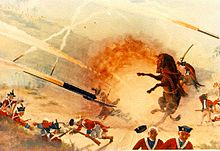 In the year 1780 the British began to annex the terrirtories of the Sultanate of Mysore, during the Second Anglo-Mysore War. A British battalion was defeated during the Battle of Guntur, by the forces of Hyder Ali, who effectively utilized Mysorean rockets and Rocket artillery against the closely massed British forces.
In the year 1780 the British began to annex the terrirtories of the Sultanate of Mysore, during the Second Anglo-Mysore War. A British battalion was defeated during the Battle of Guntur, by the forces of Hyder Ali, who effectively utilized Mysorean rockets and Rocket artillery against the closely massed British forces.
The Mysore rockets utilized by Hyder Ali during the Battle of Pollilur were much more advanced than the British East India Company had previously seen, chiefly because of the use of iron tubes for holding the propellant; this enabled higher thrust and longer range for the missile (up to 2 km range). After Tipu Sultan's eventual defeat in the Fourth Anglo-Mysore War and the capture of the Mysore iron rockets, they were influential in British rocket development, inspiring the Congreve rocket, which was soon put into use in the Napoleonic Wars.[2]
Types of Mughal army unit
Cavalry
Sowar
The word Sowar means 'The one who rides' in Persian, was originally a rank during the Mughal period. The term had been used to define a horse-soldier belonging to the cavalry troops of the Mughal armies in South Asia. It is also used more specifically of a mounted orderly, escort or guard. It was also the rank held by ordinary cavalry troopers, equivalent to Sepoy in the infantry.
Zamburak
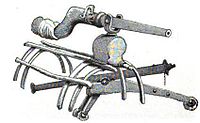 A type of Zamburak which were in use by the Mughal Empire.
A type of Zamburak which were in use by the Mughal Empire.
The Zamburak was a specialized form of camel cavalry and mobile artillery from the Muslim World after the 16th century, consisted of a soldier on a camel with a mounted swivel gun (a small falconet), which was hinged on a metal fork-rest protruding from the saddle of the animal. In order to fire the cannon, the camel would be put on its knees. The name may be derived from Arabic zambūr, hornet (possibly in reference to the sound earlier camel-mounted crossbows made). The mobility of the camel combined with the flexibility and heavy firepower of the swivel gun to make an intimidating military unit.
The soldier type was probably introduced by Egyptian Mamluk warriors who originally mounted large crossbows on the camels, the Zamburak was rapidly adopted by especially by the Persian Safavid armies, the Zamburak was introduced into the Mughal Empire by Mughal Emperor Humayun, Zamburak were used against the invading British in the Anglo-Afghan Wars.
War elephants
The elephant had a ceremonial and almost power status in the traditional Mughal court. It did have a primary role on the battlefield in early Mughal armies but was supplanted by the faster horse archer. Despite this there were often several thousands, if not tens of thousands of elephants in the Mughal army. The elephant could serve the role of a command platform to keep the general above the crowd of the battle, although it also meant that if the soldiers saw an empty seat on top of an elephant that they may think that the general was dead and flee. l seat Elephants were also kept in the reserve to move in as a very obvious block or counter penetration force if the Mughal battle line was broken. As gunpowder weapons became more prevalent on the Indian battlefield the elephant lost its place even more. It was relegated to being a beast of burden to move weapons and supplies to the front line. It did however maintain the besieging role to pull down fortifications.[3]
The elephant was as much a victim of gunpowder as was the European knight. Unlike the knight however, the elephant did not evolve on the battlefield to a new role but disappeared from the front lines and was pushed further back.
Sepoy
The word sepoy is a disambiguation of the word Persian word Sipahi, the word was commonly used by Mughals and Safavids to describe individual infantry soldiers, the Ottoman Turks used the word to describe the elite Cavalry Sipahi.
The Sipahi were native Mughal musketeer units in the Mughal Empires basic military units, most of them carried Talwars and Sheilds, a special class known as the Atishbaz carried Mughal guns such as Muskets, the Atishbaz served under a Mir Atish (Mir of gunpowder weaponry).
Mahout
A howdah, or houdah, also known as Hathi Howdah, a carriage which is positioned on the back of an elephant, or occasionally some other animal, used most often in the past to carry wealthy people or for use in hunting or warfare. It was also a symbol of wealth for the owner, and as a result was decorated with expensive gems.[4]
Most notable are the Golden Howdah, used traditionally during the Jamboo Savari (Elephant Procession) of the famous Mysore Dasara. The Museum at Mehrangarh Fort, Jodhpur, Rajasthan has a gallery of royal Howdahs.
Transport
Howdah
 A panorama in 12 folds showing the procession of the last Mughal Emperor Bahadur Shah II to celebrate the feast of the Eid ul-Fitr in 1843.
A panorama in 12 folds showing the procession of the last Mughal Emperor Bahadur Shah II to celebrate the feast of the Eid ul-Fitr in 1843.
A howdah, or houdah, also known as Hathi Howdah, a carriage which is positioned on the back of an elephant, or occasionally some other animal, used most often in the past to carry wealthy people or for use in hunting or warfare. It was also a symbol of wealth for the owner, and as a result was decorated with expensive gems.
Most notable are the Golden Howdah, used traditionally during the Jamboo Savari (Elephant Procession) of the famous Mysore Dasara. The Museum at Mehrangarh Fort, Jodhpur, Rajasthan has a gallery of royal Howdahs.
 Death of Sultan Bahadur at Diu, in front of the Portuguese, in 1537.[5] Akbar Nama, end of 16th century.
Death of Sultan Bahadur at Diu, in front of the Portuguese, in 1537.[5] Akbar Nama, end of 16th century.
The Mughals also maintained various river fleets of Dhows, which transported soldiers over rivers and fought rebels. Among its admirals were Yahya Saleh, Munnawar Khan, Sidi Yaqub, and Muhammad Saleh Kamboh. The Mughals also protected the Siddis of Janjira and the ports of Thatta. Its sailors were renowned and often voyaged to China and the East African Swahili Coast, together with some Mughal subjects carrying out private-sector trade.
References
- ^ Exhibition at the Metropolitan Museum of Art, New York.
- ^ Roddam Narasimha (1985). Rockets in Mysore and Britain, 1750-1850 A.D. National Aeronautical Laboratory and Indian Institute of Science.
- ^ http://3.bp.blogspot.com/_UR6_hWgyQjQ/R9HrwVnq3UI/AAAAAAAAAPQ/DkS9zva1_2s/s1600/Kota_war_elephant.JPG
- ^ http://www.spongobongo.com/her9654.htm
- ^ The Cambridge history of the British Empire, Volume 2 by Arthur Percival Newton p.14
Categories:- Mughal Empire
- Weapons of India
Wikimedia Foundation. 2010.





